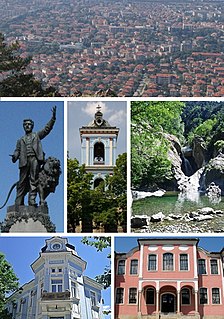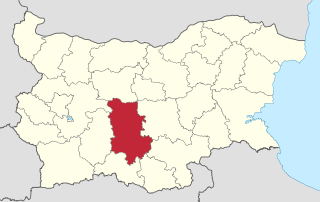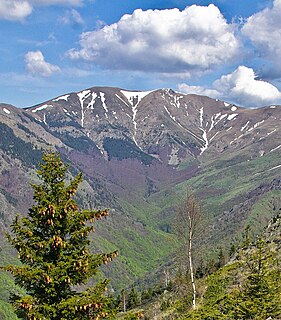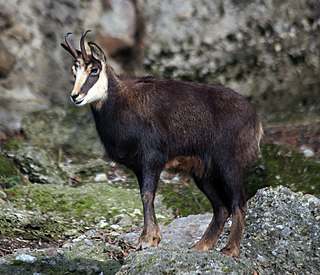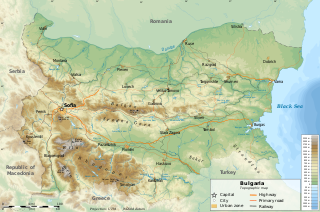
Bulgaria is a country situated in Southeast Europe, bordering Romania to the north, Serbia and North Macedonia to the west, Greece and Turkey to the south, and the Black Sea to the east. The northern border with Romania follows the river Danube until the city of Silistra. The land area of Bulgaria is 110,879 square kilometres (42,811 sq mi), slightly larger than that of Iceland or the U.S. state of Tennessee. Considering its relatively small size, Bulgaria has a great variety of topographical features. Even within small parts of the country, the land may be divided into plains, plateaus, hills, mountains, basins, gorges, and deep river valleys. The geographic center of Bulgaria is located in Uzana.
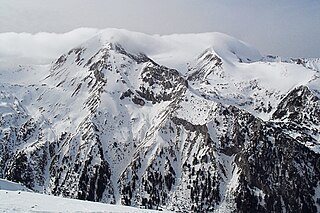
The Pirin Mountain are a mountain range in southwestern Bulgaria, with Vihren at an altitude of 2,914 m being the highest peak. One hypothessis is the mountain was named after Perun, the highest god of the Slavic pantheon and the god of thunder and lightning. Another version is that the etymology of the range derives from the Thracian word Perinthos, meaning "Rocky Mountain".
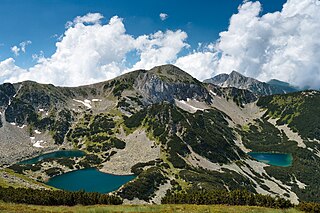
Pirin National Park, originally named Vihren National Park, encompasses the larger part of the Pirin Mountains in southwestern Bulgaria, spanning an area of 403.56 km2 (155.82 sq mi). It is one of the three national parks in the country, the others being Rila National Park and Central Balkan National Park. The park was established in 1962 and its territory was expanded several times since then. Pirin National Park was declared a UNESCO World Heritage Site in 1983. The altitude varies from 950 m to 2,914 m at Vihren, Bulgaria's second highest summit and the Balkans' third.

Kopaonik is a mountain located in Serbia. It is the largest mountain range in Serbia. The highest point is the Pančić's Peak with 2,017 m (6,617 ft). The central part of the Kopaonik plateau was declared a national park in 1981 which today covers an area of 121.06 km2 (46.74 sq mi).
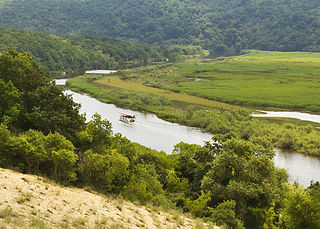
The Ropotamo is a river in south-eastern Bulgaria. It takes its source from the Bosna Ridge in the Strandzha Mountains, running for 48.5 km to empty into the Black Sea near Cape Saint Demetrius between Dyuni and Primorsko.
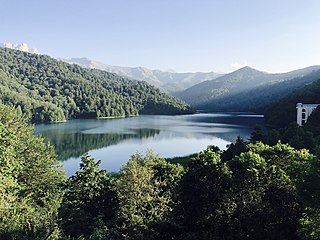
Göygöl National Park — is a national park of Azerbaijan. It was established by the decree of the President of Azerbaijan Ilham Aliyev, in an area in Goygol Rayon administrative district on April 1, 2008 on the basis of the former "Goy Gol State Reserve" that was established in 1925 and which it superseded, on a surface area of 12,755 hectares (127.55 km2). It was enlarged from 6,739 hectares (67.39 km2) of the former state reserve to its current surface area as a national park.

Silkosia is a nature reserve in Strandzha Nature Park, located in the homonymous mountain, southeastern Bulgaria. Its territory close to the villages Kosti and Balgari. Silkosia is the oldest reserve in the country, declared on 23 July 1931 in order to protect the evergreen bushes unique for Europe. It encompasses part of the Veleka river catchment area with a territory of 389.6 ha or 3.896 km2. The terrain is various, in the lower parts there are predominantly swamp areas with typical Central European flora. The reserve encompasses territory between 100 and 250 m altitude and is thus among the lowest-lying nature reserves in the country.

Belasitsa Nature Park covers the northern slopes of Belasitsa Mountain in the Southwest Region of Bulgaria. The total area of the park is 117 km². Belasitsa is part of the European ecological network NATURA 2000 and is managed by the Belasitsa Nature Park Directorate which is a legal entity under the authority of the Executive Forest Agency of Ministry of Agriculture and Food. The Directorate office is located in the village of Kolarovo.
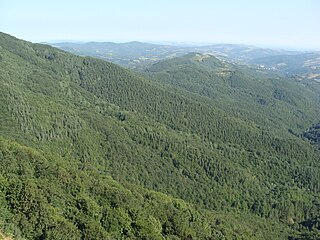
The Bulgarka Natural Park is a Bulgarian nature park on the northern slopes of the Balkan Mountains, occupying 22,000 hectares of territory in the central and eastern part of the mountains between the cities of Gabrovo and Kazanluk.

The Nera Gorge-Beușnița National Park is a protected area situated in Romania, in Caraş-Severin County.

The Rodope montane mixed forests constitute a terrestrial ecoregion of Europe defined by the WWF. It belongs in the Temperate broadleaf and mixed forests Biome and the Palearctic ecozone. There are three national parks in the ecoregion, all of them situated in Bulgaria: Central Balkan National Park, Pirin National Park, a UNESCO world heritage site, and Rila National Park.
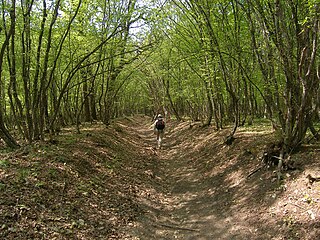
The Shumen Plateau Nature Park is located in the Shumen Plateau of the northern province of Shumen of Bulgaria, the highest plateau of the Danubian Plain. The Park encloses the Bukaka Reserve Forest, which is known for indigenous Fagus sylvatica Fagus sylvaticamoesiaca forest. This Park was declared a National Park in 1980 and a Nature Park in 2003 to conserve its ecosystems and floral and faunal biodiversity, and to preserve its tableland landscape together with many tourist sites such as the Shumen fortress, the Monument to 1300 Years of Bulgaria, cave monasteries, and surface and underground karst caves. The park has the first thematic educational trail in the Karst Nature Park, constructed as part of a project titled "Natural Park of Shumen Plateau" with funds provided by the EU Cohesion Fund and the Republic of Bulgaria; the trail is integral to the Operational Program "Environment 2007–2013".

Uzunbodzhak, also transliterated as Ouzounboudjak is an UNESCO Biosphere Reserve, one of the five nature reserves in Strandzha Nature Park in south-eastern Bulgaria. The reserve is sometimes called Lopushna. Uzunbodzhak was established on 13 December 1956 and was included in the UNESCO network of biosphere reserves in March 1977. It covers an area of 2529.6 hectares, or 25.296 km2. All economic activities are prohibited on the territory of the reserve.

Bayuvi Dupki–Dzhindzhiritsa, also spelled Doupki–Djindjiritza, is a nature reserve in Pirin National Park, located in the homonymous mountain range in south-western Bulgaria. It is situated in Razlog Municipality, Blagoevgrad Province. Bayuvi Dupki–Dzhindzhiritsa is among the nation's oldest reserves, declared in 1934 to protect the forests of Macedonian pine and Bosnian pine, both Balkan endemic species. Its territory was further expanded in 1976 and 1980 and spans an area of 2873 ha or 28,73 km2. It was declared a UNESCO Biosphere Reserve in 1977. The reserve encompasses territory between 1200 and 2907 m altitude. Geologically it is dominated by Proterozoic marbles and has extensive karst terrain with numerous caves and karst formations.

Ali Botush, also spelled Alibotoush, is a nature reserve in the small mountain range of Slavyanka, located on the border between Bulgaria and Greece. The reserve occupies the northern section of the mountain which lies within the territory of Bulgaria and takes its name from the old name of Slavyanka. It is situated in the municipalities of Sandanski and Hadzhidimovo, Blagoevgrad Province. It was declared in 1951 to protect the largest forests of the endemic Bosnian pine in the Balkan Peninsula. Its territory was further expanded several times and spans an area of 1638 ha or 16,38 km2. It was declared a UNESCO Biosphere Reserve in 1977.

Tisata is a nature reserve in south-western Bulgaria. It is situated in Kresna Municipality, Blagoevgrad Province. The reserve is managed by the administration of Pirin National Park despite the fact it lies outside the limits of the park.

Orelyak is a nature reserve in the central section of the Pirin mountain range in south-western Bulgaria. It is situated in Gotse Delchev Municipality, Blagoevgrad Province. It was declared on 22 February 1985 to protect old growth beech forests it the vicinities of Mount Orelyak (2,099 m), the highest summit in Central Pirin. It spans a territory of 757 ha or 7.57 km2.

Primula frondosa, the leafy primrose, is a species of flowering plant in the family Primulaceae, native to the Balkans. It inhabits shady spots in a small region of the central Balkan Mountains range in Bulgaria, where it is found at altitudes from 800 to 2,200 m. Its populations are situated within the boundaries of the Central Balkan National Park and the nature reserves Sokolna, Dzhendema and Stara Reka.





